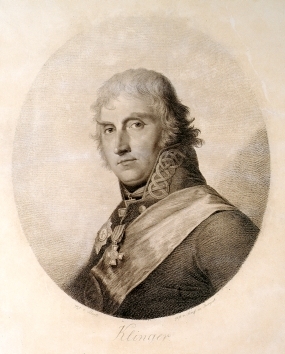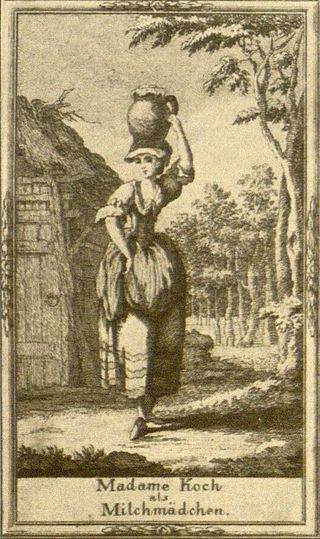
Friedrich Maximilian von Klinger was a German dramatist and novelist. His play Sturm und Drang (1776) gave its name to the Sturm und Drang artistic epoch. He was a childhood friend of Johann Wolfgang von Goethe and is often closely associated with Jakob Michael Reinhold Lenz. Klinger worked as a playwright for the Seylersche Schauspiel-Gesellschaft for two years, but eventually left the Kingdom of Prussia to become a General in the Imperial Russian Army.
This article contains information about the literary events and publications of 1777.

Heinrich Leopold Wagner was a German dramatist of the Sturm und Drang movement.

Anton Schweitzer was a German composer of operas, who was affiliated with Abel Seyler's theatrical company.

Konrad Ekhof was a German actor, often regarded as the foremost actor of German-speaking Europe in the 18th century. He was noted for his collaboration with the theatre principal Abel Seyler in the 1760s and 1770s, first at the Hamburg National Theatre and then at the travelling Seyler Theatre Company.

Georg Anton Benda was a composer, violinist and Kapellmeister of the classical period from the Kingdom of Bohemia.

Weimar Classicism was a German literary and cultural movement, whose practitioners established a new humanism from the synthesis of ideas from Romanticism, Classicism, and the Age of Enlightenment. It was named after the city of Weimar, Germany, because the leading authors of Weimar Classicism lived there.
Sturm und Drang was a proto-Romantic movement in German literature and music that occurred between the late 1760s and early 1780s. Within the movement, individual subjectivity and, in particular, extremes of emotion were given free expression in reaction to the perceived constraints of rationalism imposed by the Enlightenment and associated aesthetic movements. The period is named after Friedrich Maximilian Klinger's play of the same name, which was first performed by Abel Seyler's famed theatrical company in 1777.

Friedrich Johann Justin Bertuch was a German publisher and patron of the arts. He co-founded the Weimar Princely Free Drawing School with the painter Georg Melchior Kraus in 1776. He was the father of the writer and journalist Karl Bertuch.

Johann Anton Leisewitz was a German lawyer and dramatic poet, and a central figure of the Sturm und Drang era. He is best known for his play Julius of Taranto (1776), that inspired Friedrich Schiller and is considered the forerunner of Schiller's quintessential Sturm und Drang work The Robbers (1781).

Friederike Sophie Seyler was a German actress, playwright and librettist. Alongside Friederike Caroline Neuber, she was widely considered Germany's greatest actress of the 18th century; Gotthold Ephraim Lessing described her in his Hamburg Dramaturgy as "incontestably one of the best actresses that German theatre has ever seen."

Abel Seyler was a Swiss-born theatre director and former merchant banker, who was regarded as one of the great theatre principals of 18th century Europe. He played a pivotal role in the development of German theatre and was considered "the leading patron of German theatre" in his lifetime. He supported the development of new works and experimental productions, helping to establish Hamburg as a center of theatrical innovation and to establish a publicly funded theater system in Germany. Working with some of Germany's foremost actors and playwrights of his era, he is credited with pioneering a new more realist style of acting, introducing Shakespeare to a German language audience, and with promoting the concept of a national theatre in the tradition of Ludvig Holberg, the Sturm und Drang playwrights, and serious German opera, becoming the "primary agent for change in the German opera scene" in the late 18th century. Already in his lifetime, he was described as "one of German art's most meritorious men."
Sturm und Drang is a play in five acts by Friedrich Maximilian Klinger, which gave its name to the artistic period known as Sturm und Drang. The play was first performed in Leipzig on 1 April 1777 by Abel Seyler's theatre company, where Klinger then was employed as a playwright. The play's original title was Wirrwarr; it was changed to Sturm und Drang before premiering.

Oberon, or The Elf King, or simply Oberon, originally known as Huon and Amanda, is a romantic Singspiel in five acts by Friederike Sophie Seyler, inspired by the poem Oberon by Christoph Martin Wieland, which itself was based on the epic romance Huon of Bordeaux, a French medieval tale. It has been named for two of its central characters, the knight Huon and the fairy king Oberon, respectively. Musicologist Thomas Bauman describes the work as "an important impulse for the creation of a generation of popular spectacles trading in magic and the exotic. Die Zauberflöte [The Magic Flute] in particular shares many features with Oberon, musical as well as textual."

The Seyler family is a Swiss family, originally a patrician family from Liestal near Basel. Family members served as councillors and Schultheißen of Liestal from the 15th century, later also as members of the Grand Council of Basel. A Hamburg branch descended from the banker and renowned theatre director Abel Seyler became by marriage a part of the Berenberg banking dynasty, co-owners of Berenberg Bank and part of Hamburg's ruling class of Hanseaten.
Abel Jacob Gerhard Seyler (1756–1805), also known as Abel Seyler the Younger, was a German scholar, pharmacist, freemason and a member of the original Illuminati order. Described as highly erudite, he was court pharmacist in Celle from 1791 to 1803, and also owned the famous Andreae & Co. court pharmacy in Hanover with his two siblings as co-owners from 1793 to 1803.
Georg August Wilhelm Seyler was a German theologian and priest, and the adoptive father of Felix Hoppe-Seyler, the principal founder of biochemistry and molecular biology.

Franziska Romana Koch, née Gieraneck, Giwraneck, Giraneck, Jiránek (1748–1796) was a German ballet dancer, soprano, and actress. First a dancer as the member of the theatre company Kochische Gesellschaft, she also trained her voice and worked at the court theatre of Weimar. Anton Schweitzer composed the opera Alceste for her, and its librettist Christoph Martin Wieland celebrated her performance in the title role in a poem. She later worked in Gotha, and finally in Leipzig as a member of Bondini's company, where she retired in 1787.

Deutsche Wanderbühne is the term for roving German-speaking, theatrical troupes or travelling operas, consisting of professional actors and musicians. They were financially independent but did not have their own fixed stage.

Anna Elisabeth Toscani, née Endemann, was a German actress. She was a student of Friederike Sophie Seyler and was one of the leading actresses of the Mannheim National Theatre from 1779 to 1784. She is also notable for being the first "Amalia" in the original performance of Friedrich Schiller's The Robbers on 13 January 1782 at Mannheim.

















